5 Nights 6 Days
Daily Tour
12 people
___
| Semi Deluxe | ||
|---|---|---|
| ADULT | CHILD | INFANT |
| ₹31,000.00 | ₹0.00 | ₹0.00 |
| Deluxe | ||
| ADULT | CHILD | INFANT |
| ₹33,000.00 | ₹0.00 | ₹0.00 |
| Super Deluxe | ||
| ADULT | CHILD | INFANT |
| ₹35,000.00 | ₹0.00 | ₹0.00 |
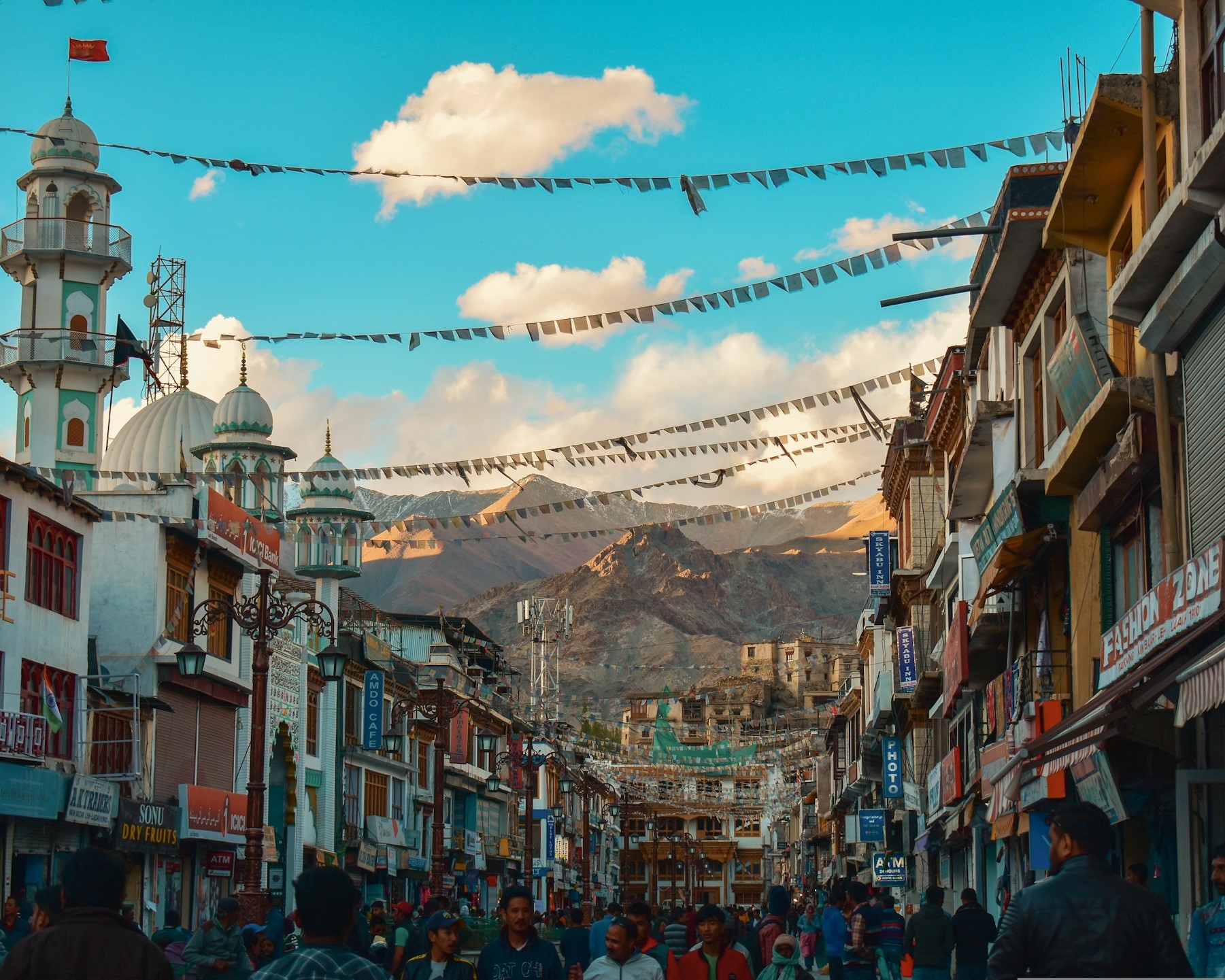
We will pick you up from the Leh airport. After checking in to the hotel and freshening up you will visit the Leh Palace, Shanti Stupa, and Leh Market. In the evening you will return to the hotel.
Meals: Dinner
Night: Stay at the hotel in Leh
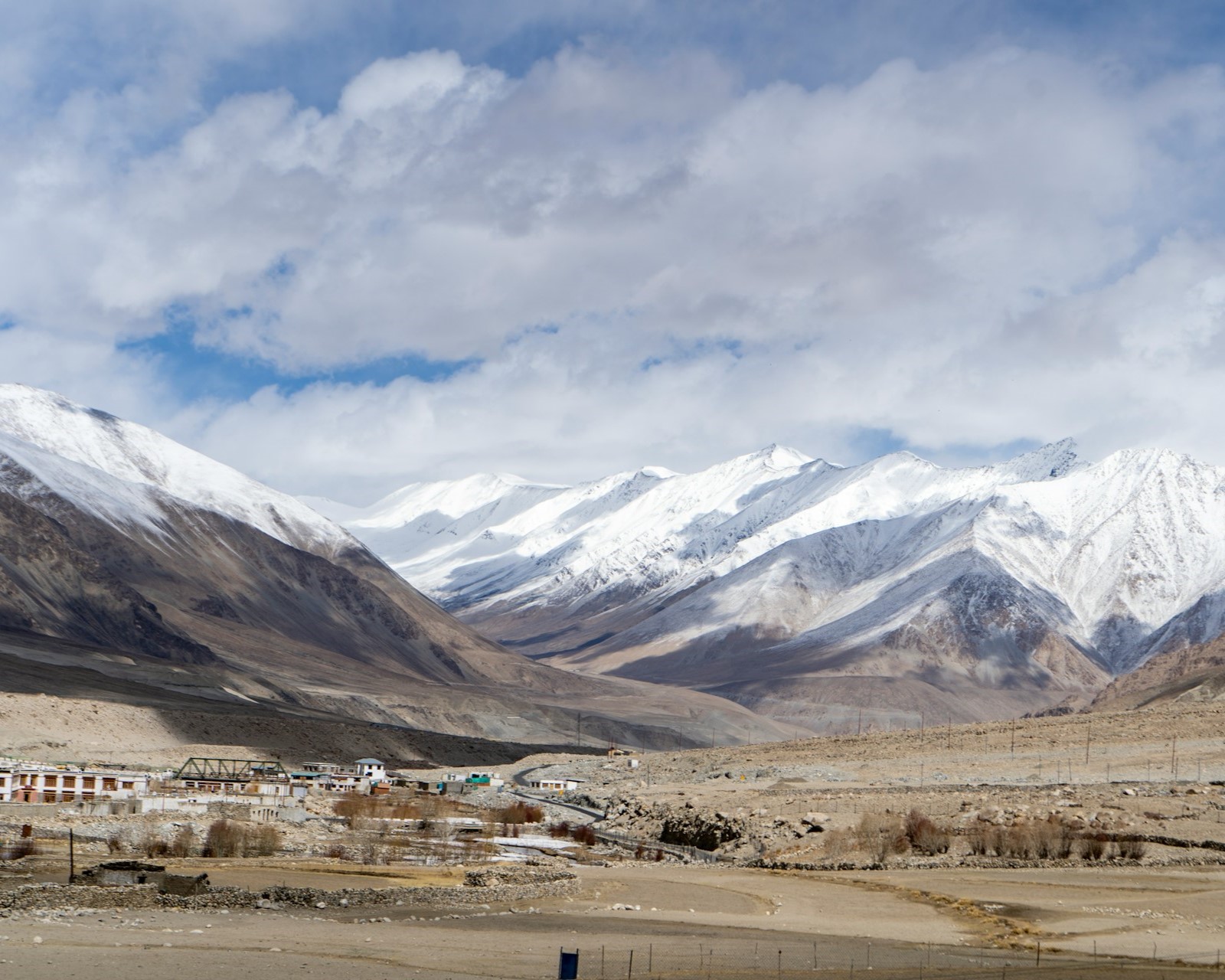
Today you will travel to the beautiful land of Agas which is Kargil. You will visit the Hall of Fame, Spituk Monastery, Gurudwara, Magnetic Hill, and Sangam rafting point
Meals: Breakfast, Dinner
Night: Stay at the hotel in Kargil
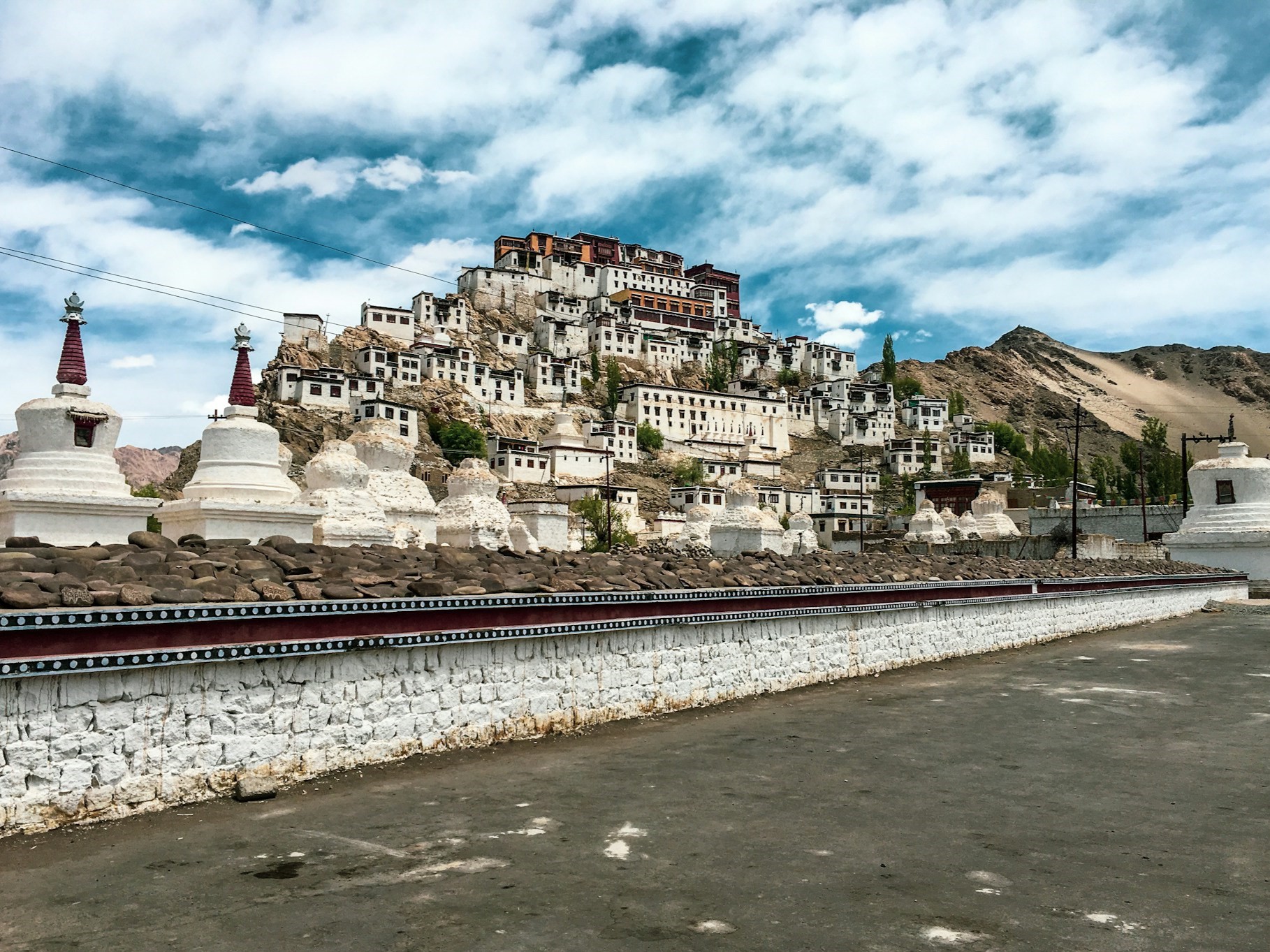
Today after breakfast you will drive back to Leh via Zojila Pass, Drass, Mulbekh, Lamayuru, Fotu la, Nimu, Khaltse, Upshi, and Karu. In the evening you will check in to the hotel.
Meals: Breakfast, Dinner
Night: Stay at the hotel in Leh
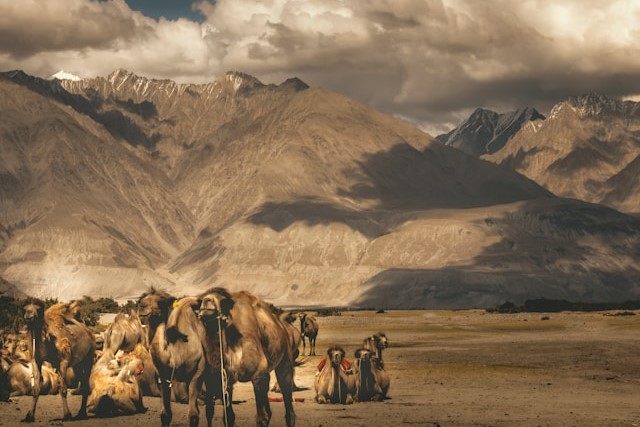
Today you will head towards Nubra Vally via Highest Motorable Pass; Khardung La. You will visit Diskit Monastery, Hunder Village, Sandunes, and Camel Ride Point. Later you will check In to your stay at Nubra valley.
Meals: Breakfast, Dinner
Night: Stay at hotel/homestay in Nubra Valley
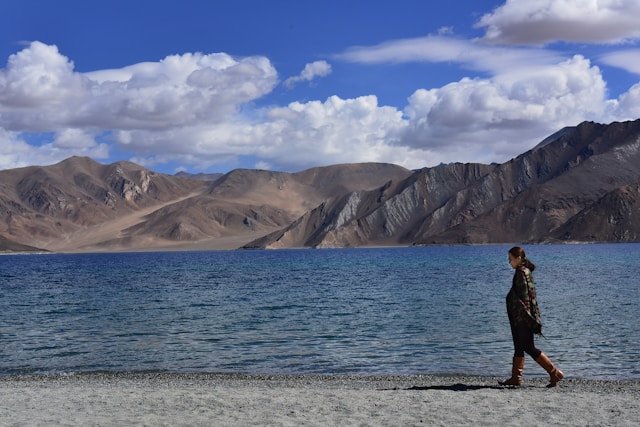
Today after waking up to the view of Karakoram ranges you will head towards a high altitude saline Lake called Pangong Tso. Nubra Valley to Pangong to Leh Shayok Village, Durbuk Village, Tangsay Village, Changla Pass. Later in the afternoon, you will head back to Leh via Chang La pass and visit Thiksey Monastery. And way back to Leh.
Meals: Breakfast, Dinner
Night: Stay at a hotel in Leh
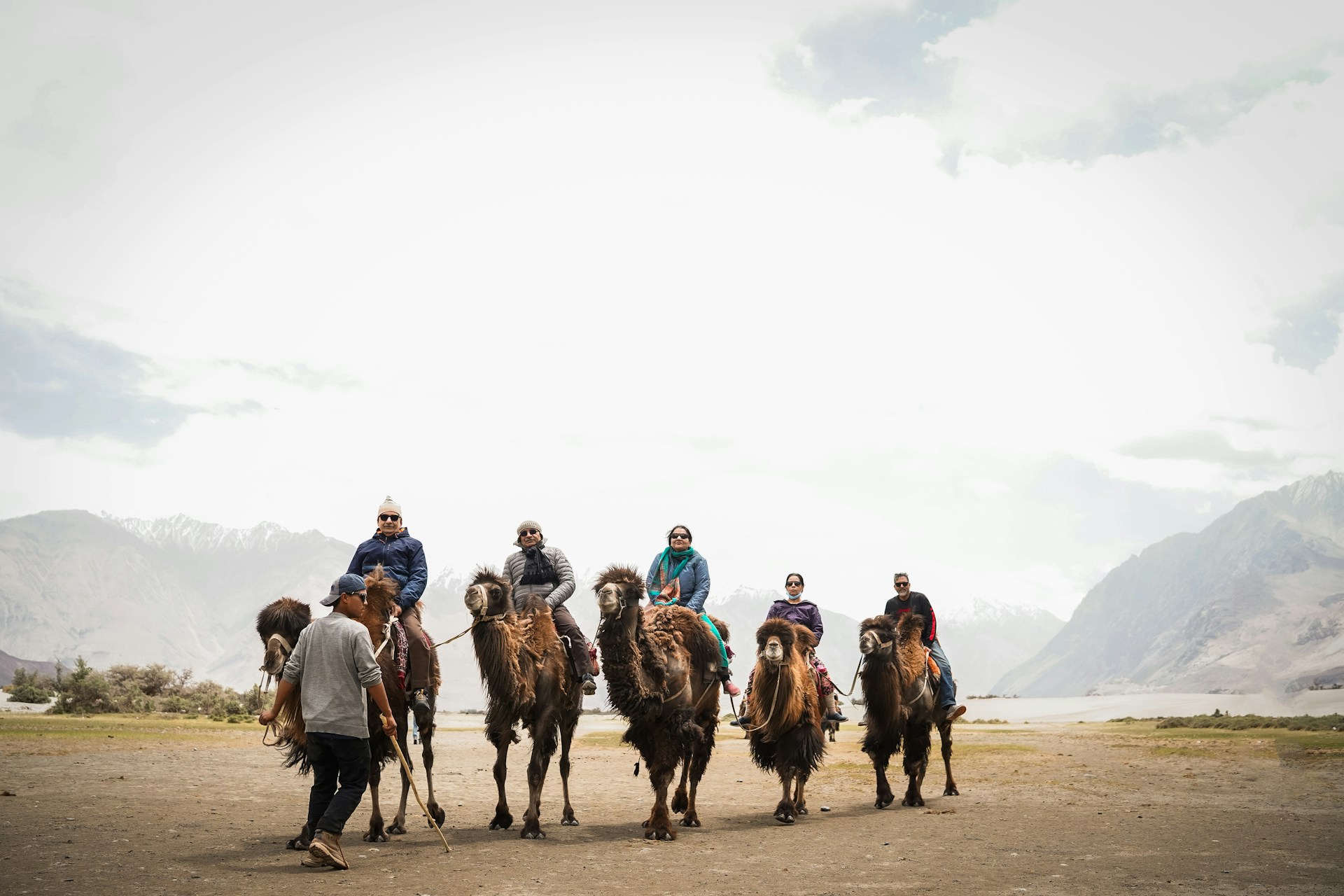
It's time to say goodbye to this fantastic tour amidst the Karakoram range. You will head towards Leh airport with lots of memories to cherish forever.
Meals: Breakfast
Night: Nil
Imagine embarking on a journey through the heart of Ladakh on the Leh Nubra Pangong Kargil Tour, where the rugged mountains meet the clear blue sky. Your adventure begins in Leh, a city that whispers tales of ancient Buddhist culture through its monasteries and markets. As you acclimatize to the high altitude, the city’s charm unfolds.
Next, you traverse the Khardung La pass, one of the world’s highest motorable roads, to reach the enchanting Nubra Valley. Here, the cold desert dunes coexist with lush greenery and serene monasteries. A ride on the double-humped Bactrian camels is a must.
Khardung La, at an elevation of 5,359 m, is historically significant as it lies on the major caravan route from Leh to Kashgar in Central Asia. It’s worth noting that some local summit signs and stores in Leh incorrectly claim its elevation to be around 5,602 m and label it as the world’s highest motorable pass.
Your journey continues to the mesmerizing Pangong Lake, a sapphire expanse that changes colors with the sun’s rays. The tranquil waters reflect the surrounding mountains, creating a landscape that leaves you breathless.
Finally, you head to Kargil, a town steeped in history. The Khardung La Pass is strategically important to India as it is used to carry supplies to the Siachen Glacier. The Kargil War Memorial stands as a reminder of the brave hearts who defended our nation.
This tour is not just a trip. It’s an experience of a lifetime, a story waiting to be lived. Are you ready to turn the page?
The nearest airport to Leh is Kushok Bakula Rimpochee Airport, which is located in Leh town itself. It is well connected to Delhi and other major cities of India via regular flights.
You can reach Leh by road from Manali, Srinagar, and other parts of India. The Manali-Leh highway is open for a few months in summer and is a good option for those who want to explore the breathtaking views of the Himalayas.
Leh does not have a railway station and the nearest railway station is Jammu Tawi, which is located at a distance of 734 kilometers from Leh. You can take a taxi or a bus from Jammu Tawi to Leh.
On the Leh Nubra Pangong Kargil Tour discover the Hall of Fame, a poignant tribute to India’s brave soldiers. Located on the Leh-Kargil Road, this two-story museum showcases the valor of those who defended our nation in the Indo-Pak wars. Inside, you’ll find the OP Vijay Gallery, displaying weapons from the Kargil war and amenities used by the Indian Army in Siachen. The “Lest We Forget” wall honors soldiers who made the ultimate sacrifice. A documentary on “Operation Vijay” can be viewed in the projection room. The museum also offers a glimpse into Ladakh’s rich history and culture. Open from 9 A.M. to 1 P.M. and 2 P.M. to 7 P.M., the entry fee is Rs. 25 per person. This journey is not just a tour, but a salute to the indomitable spirit of our soldiers.
Nestled in the heart of Ladakh, India, Shey Monastery is a 17th-century architectural marvel. This peaceful sanctuary, home to a towering 39-foot Buddha statue, is a symbol of harmony and cultural coexistence. As part of the Leh Nubra Pangong Kargil Tour, you’ll experience the monastery’s rich heritage and stunning beauty. Once a royal residence, it now serves as a spiritual and cultural hub, attracting art enthusiasts and peace seekers alike. The monastery’s vibrant festivals, including Shey Rupla and Shey Doo Lhoo, offer a glimpse into traditional dances, music, and ceremonies. With its breathtaking views and spiritual tranquillity, Shey Monastery is more than a destination; it’s an experience that encapsulates the serene beauty of Ladakh.
Thiksey is a Tibetan Buddhist monastery located near Leh. It is one of the largest and most impressive of Ladakh’s gompas (monasteries). It belongs to the Gelugpa sect of Tibetan Buddhism, also known as the Yellow Hat sect. The monastery was founded in 1433 by Sherab Zangpo of Stod, a descendant of the great translator Rinchen Zangpo. It was initially called Pethup or “Peak of the Wind”. The monastery was later expanded by Palden Sangpo, who was the disciple of Tsongkhapa, the founder of the Gelugpa sect. In the 16th century, the monastery was taken over by the Gelugpa sect and renamed Thiksey. The monastery is located on a hilltop and is composed of several buildings, including a temple, a college, a nunnery, and several residences. The main temple is two stories high and contains a large statue of Maitreya, the future Buddha. The monastery is home to around 500 monks and has a library of ancient Tibetan manuscripts and books of Buddhist philosophy. It also houses several ancient murals, statues, and stupas. Thiksey Monastery holds an annual festival in May. During this festival, the monks perform traditional dance and mask dances. The monastery also hosts an important debate session, where scholars from different Buddhist schools are invited to discuss religious topics. Thiksey is also known for its large collection of Tibetan thangkas and statues.
Shanti Stupa is a Buddhist white-domed stupa (a hemispherical structure containing relics, typically the remains of a Buddhist monk or nun) on a hilltop in the Changspa area of Leh district in the Indian union territory of Ladakh. The stupa was built in 1991 by Japanese Buddhist Bhikshu Gyomyo Nakamura and is part of the Peace Pagoda mission. Shanti Stupa holds the relics of the Buddha at its base, enshrined by the 14th Dalai Lama. Shanti Stupa was originally built in 1991 by Japanese Buddhist Bhikshu Gyomyo Nakamura in the Changspa area of Leh district in the Indian Union territory of Ladakh. The stupa is part of the Peace Pagoda mission and was built to promote world peace and prosperity. It stands at a height of 4,267 meters (14,000 feet) above sea level and overlooks the Ladakh mountain range. The stupa was built to enshrine and honor the relics of the Buddha at its base, which the 14th Dalai Lama ceremonially presented. It is believed that the stupa symbolizes the spread of Buddhism and peace throughout the world. The stupa was built with the support of the Ladakh Buddhist Association and the Japan Buddha Sangha. The 14th Dalai Lama inaugurated it on 8 August 1985 and is now a well-known tourist attraction in Ladakh. The stupa is built in a Japanese style, with four main pillars and a dome. The stupa is also adorned with prayer flags and a golden statue of the Buddha. The stupa is also a popular pilgrimage site for Buddhists from all over the world, who come to meditate and seek blessings from the Buddha. The Shanti Stupa is a living symbol of peace and a reminder that peace and harmony can be achieved through understanding and tolerance.
The Leh Palace is a former royal palace in Leh, the capital of Ladakh, India. It was built in the 16th century by King Sengge Namgyal, who also founded the Namgyal dynasty of Ladakh. The palace is nine stories high and is modeled on the Potala Palace in Tibet. The palace is situated on Tsemo Hill and provides spectacular views of the surrounding landscape, including parts of the Indus River valley and the Stok Kangri mountain range. The palace was damaged in the mid-17th century by Mongol forces and was later restored by King Tsewang Namgyal. In the 18th century, the palace was expanded by King Tsewang Namgyal, who built a new fort in the palace’s lower parts. The palace went through many difficult periods in the 19th century and was eventually abandoned in the early 20th century when the Dogra forces invaded Ladakh. The palace was further damaged during the Indo-Pakistani War of 1947-48 and was abandoned for many years. In the late 1970s, the palace was declared a protected monument by the Archaeological Survey of India. It was restored in the 1990s and is now open to the public. It houses a museum, which contains a collection of ancient artifacts and paintings. Today, the Leh Palace is a popular tourist destination, attracting visitors from all over the world. It is also a popular venue for cultural events and functions, including traditional dances and music performances. This is one of the must-visit places during Leh Nubra Pangong Kargil Tour
Leh Market is renowned for its traditional Ladakhi handicrafts, jewelry, and other goods. The Leh Market has a long and rich history that dates back to the 15th century when the Ladakh region was a part of the Tibetan Empire. The market was a popular trading post with traders from Central Asia, Tibet, China, Kashmir, and Baltistan. The city of Leh became a major trading hub for wool, pashmina, salt, tea, and other goods. It continued to thrive and even expanded with the introduction of new goods such as silk, jewelry, and carpets. The market is now a popular tourist destination in the region and attracts many visitors from all over the world. The market is known for its various traditional handicrafts, jewelry, traditional Ladakhi attire and accessories, carpets, dried fruits, and other goods. The market is also home to several shops selling antiques, books, and other artifacts. The Leh market is also known for its vibrant and colorful culture. During festivals and special occasions, the market comes alive with singers, dancers, and vendors selling traditional Ladakhi food and other items. The market is also home to many small restaurants and cafes, which offer a variety of cuisines from the region. Leh Market is a great place to experience the culture and traditions of Ladakh and explore the various handicrafts and artifacts available in the region.
Gurudwara Patthar Sahib is a historic gurudwara located in the town of Leh (Leh Nubra Pangong Kargil Tour), in the Union Territory of Ladakh, India. The gurudwara was built in the 17th century by Guru Gobind Singh, the tenth Sikh Guru. It is said to have been built in remembrance of his visit to the city. The gurudwara is situated on the banks of the Indus River, near the ancient city of Leh. It is believed to be the site of the battle between Guru Gobind Singh and the Mughal forces, who were trying to capture the city in 1699. The Gurudwara is an important pilgrimage site for Sikhs from all over the world, who come to pay their respects to Guru Gobind Singh and his teachings. The gurudwara is a beautiful white marble structure and contains a large prayer hall and several small rooms for worship. The gurudwara is also a popular tourist attraction, as it provides a glimpse into the history and culture of the region. The gurudwara is home to several sacred relics, including a copy of the Guru Granth Sahib, the holy book of the Sikhs, and several weapons and other artifacts. Several festivals and events are held at the gurudwara throughout the year, including the Guru Gobind Singh Birthday Festival, the Guru Nanak Birthday Festival, and the Guru Gobind Singh Martyrdom Day. Gurudwara Patthar Sahib is an important part of Sikh history and culture and is a place of great spiritual and historical significance. It serves as a reminder of the courage, bravery, and dedication of Guru Gobind Singh and his followers to the Sikh faith.
Magnetic Hill is a gravity hill located near Leh in Ladakh, India. The hill has an optical illusion in which a slight downhill slope appears to be an uphill slope. It is located on the Leh-Kargil-Batalik highway, about 30 kilometers from Leh, at a height of 14,000 feet above sea level. The phenomenon of Magnetic Hill was known to locals for centuries and a British Army Officer first noticed it in the early 20th century. Since then, the hill has become a popular tourist attraction. The local people believe that the hill has a magnetic force, which causes a mysterious pull on vehicles that pass through it. Scientifically, the phenomenon is explained by the fact that the downhill slope of the hill is not visible due to the surrounding hills and mountains. When a car is parked on the hill and its engine is turned off, it appears to move uphill due to the optical illusion. The hill is also associated with many supernatural stories. According to one legend, a saint used to meditate on the hill, and it was believed that he had magical powers. It was also believed that the hill had the power to pull objects toward it. Today, the hill is a popular tourist destination and numerous vehicles stop to experience the phenomenon. Tourists can also enjoy the beautiful view of the valley and the snow-capped mountains from the top of the hill.
Rafting Point in Leh is one of the most popular adventure activities in Leh (Leh Nubra Pangong Kargil Tour). It is located at a distance of about 8 km from the city center, on the banks of the Indus River. Rafting Point in Leh was first established by the Tibetan refugees who made their way to the region during the 1950s. It quickly became a popular spot for locals and tourists alike to enjoy the thrill of white water rafting in Leh. The Indus River is one of the most powerful rivers in the world and is a great place for experienced and novice rafters alike. It is a great place to experience the stunning beauty of the Himalayas, as well as the thrill of the rapids. Rafters can choose from a variety of packages that offer different levels of difficulty and difficulty levels. Rafting Point in Leh offers a variety of packages that are tailored to suit the needs of the rafters. They include rafting trips ranging from day trips to overnight trips, as well as packages that include camping and other activities. Safety is of utmost importance at Rafting Point in Leh and all trips are accompanied by experienced guides. All the necessary safety equipment is provided, and the guides are well-informed and trained to ensure the safety of all rafters. Rafting Point in Leh is an ideal destination for those looking for an adrenaline-filled adventure. It is a great way to experience the breathtaking beauty of the Himalayas and the thrill of the rapids.
Khardung La is a mountain pass located in the Ladakh region of India. It is located at an elevation of 5,359 m (17,582 ft) and is considered to be the highest motorable pass in the world. It is one of the most popular tourist destinations in the region and is known for its picturesque views of the Himalayas, and its challenging terrain. The pass was first discovered in 1839 by a British officer, Claude White, who was attempting to map the area. He named the pass “Khardung La”, which means “the pass of the great gate”. In the 1950s, the Indian Army began using the pass as a strategic military route, connecting the Siachen Glacier with Leh. In the late 1970s, it was opened to tourists and adventurers, and it has since become a popular spot for trekking and mountain biking. The pass is also home to the historic Galta Monastery, which was built in the 16th century and is believed to be the oldest surviving Buddhist monastery in the region. Today, Khardung La is a major tourist destination and is popular among both trekkers and motorcyclists alike. Its unique landscape and challenging terrain make it an ideal spot for adventure-seekers looking to experience the breathtaking beauty of the Himalayas.
Diskit Village is a small village in India’s Nubra Valley of Leh district. It is situated at an elevation of 3160 m and is a popular tourist attraction. The village is home to the Diskit Monastery, the oldest and largest monastery in the Nubra Valley. The village was founded in the 15th century and is believed to be one of the oldest villages in Ladakh. The village is known for its ancient traditions and culture. It is home to the Diskit Monastery, which Changsem Sherab Zangpo founded in the 14th century. This monastery is the oldest and largest in the Nubra Valley and is believed to be the first of its kind in Ladakh. It houses many ancient artifacts, including the oldest scripture of Buddhism, the Kangyur. The village is also home to several other ancient monuments, such as the Diskit Stupa and the Chamba Temple, which is believed to be more than 600 years old. The village also hosts the annual Ladakh Festival, which is celebrated in September and is a great opportunity to witness the culture, traditions, and lifestyle of the people of Diskit. The village is a great destination for tourists looking to explore the beauty of Ladakh. From here, visitors can explore the Nubra Valley and the nearby villages of Sumur and Panamik. Trekking is also popular in the area, with several trekking routes available in the region. The Diskit village is also a great base for visitors who wish to explore the rest of the Nubra Valley.
Diskit Monastery is a Buddhist monastery located in the Nubra Valley of Ladakh, India. It was founded by Changzem Tserab Zangpo, a disciple of Tsongkhapa, and belongs to the Gelugpa sect of Tibetan Buddhism. It is the oldest and largest Buddhist monastery in the Nubra Valley and is known for its giant statues of Maitreya and Padmasambhava. The Diskit Monastery was founded in 1420 by Changzem Tserab Zangpo, a disciple of Tsongkhapa, the founder of the Gelugpa sect of Tibetan Buddhism. The monastery has been rebuilt several times, most recently in the late 19th century when it was expanded from a single temple to its current size. The monastery is the main attraction of the Nubra Valley and is known for its giant statues of Maitreya and Padmasambhava, which can be seen from the road below. The monastery complex is made up of several buildings, including a main temple, a library, an old meditation hall, and several smaller temples. The main temple houses the large statues of Maitreya and Padmasambhava, both of which are around six meters tall. The library contains ancient manuscripts, some of which are said to date back to the 9th century. The meditation hall is used by monks and other visitors for meditation and prayer. The monastery is home to around 120 monks, who are responsible for its daily running and upkeep. The monks are members of the Gelugpa school of Tibetan Buddhism and observe the same practices and rituals as those of other monasteries in the region. The Diskit Monastery is an important pilgrimage site for Buddhists, who come from all over the world to pay homage and offer prayers. It is also a popular tourist destination, with many visitors drawn to the magnificent statues, ancient manuscripts, and peaceful atmosphere of the monastery.
Sand Dunes in Leh, also known as the Nubra Valley, are a popular tourist attraction in India. Located in the Ladakh region, the dunes stretch for over 100 kilometers and reach heights of up to 500 meters. The dunes are a spectacular sight to behold, with golden sand flowing over hills and valleys, creating an ever-changing landscape. The history of the dunes in Leh dates back thousands of years, with evidence of human settlements in the area as early as 5000 BC. Local legends tell stories of ancient civilizations that lived in the area and worshipped the dunes as a symbol of fertility and abundance. The area was once a major hub of trade, thanks to its strategic location on the Silk Road. In recent years, the dunes in Leh have become a popular tourist destination. The dunes offer breathtaking views of the surrounding mountains and valleys, and visitors can enjoy activities such as camel rides, sandboarding, trekking, and stargazing. The area is full of wildlife, including rare species of birds and mammals, which can be seen at the nearby Nubra Nature Reserve. The dunes in Leh are a beautiful reminder of the area’s long and fascinating history and a must-visit destination for anyone looking for a unique travel experience.
Camel Ride Point in Leh is a popular tourist attraction located in the heart of Leh, India. The area has a rich history that dates back to the 15th century when it served as a caravan route between India and Tibet. Since then, Camel Ride Point in Leh has become a popular tourist destination for both domestic and foreign travelers alike. Camel Ride Point in Leh is located near Leh Palace and is a great way to experience the local culture and scenery. Visitors will find a wide variety of camel rides available, from short rides around the city to longer rides that take visitors out into the majestic mountains and valleys of the region. Camel Ride Point in Leh is a great spot for sightseeing, as the area offers stunning views of the Himalayas and snow-covered peaks. There are also several nearby monasteries and ancient buildings that provide great insight into the local culture and history. The area also offers a few restaurants, cafes, and souvenir shops where visitors can purchase local items such as jewelry, clothing, and carpets. Camel Ride Point in Leh is also home to a festival that takes place every year in August, which celebrates the traditional culture of the region. Whether you’re looking for a unique experience or a chance to explore the local area, Camel Ride Point in Leh is worth a visit.
Hunder is a small village located in the Nubra Valley of the Ladakh region in India. The village is located about 10 km to the north of the town of Diskit and is about 150 km from Leh. The village of Hunder is believed to have been established in the 19th century by the Changpa nomads. The Changpa people are a semi-nomadic tribe from the Tibetan Plateau who migrated to the Ladakh region in search of a better life. Over time, the Changpa people established a permanent settlement along the banks of the Shyok River in the Nubra Valley. The village is known for its double-humped Bactrian camels, which were once used as a form of transport in the region. The camels are now used mainly for tourist rides, allowing visitors to explore the dunes of the Nubra Valley. Hunder is also home to several Buddhist monasteries, including the Diskit Monastery, built in the 14th century. The village also features several ancient stupas, which are believed to be over 1000 years old. Hunder is a popular tourist destination in the Ladakh region, attracting visitors from all over the world. The village offers visitors a unique insight into the culture and tradition of the Changpa people, as well as stunning views of the Himalayan and Karakoram mountain ranges.
Shyok River is a tributary of the Indus River in Ladakh. It originates from the Rimo Glacier in the Karakoram Range and flows northwest until it merges with the Indus River near the small town of Khalsi. The Shyok River has an important place in the history of Ladakh. It was once part of the ancient Silk Route, which connected China with Central Asia, Europe, and the Middle East. During the 16th century, the Mughal Emperor Akbar used the Shyok River to transport horses and other goods from Kashmir to the Ladakh region. The river has also been an important source of water for the people of Ladakh. The water from the Shyok River is used for irrigation, drinking, and other purposes. The river also serves as a natural boundary between India and Pakistan in this region. The Shyok River has also been an important source of hydroelectric power. In the 1950s, the Indian government built a dam on the river to generate electricity. The Shyok Dam, as it is known, is still in use today and provides electricity to the region. The Shyok River is also a popular spot for tourists. It is known for its picturesque beauty and is a popular destination for rafting, fishing, and kayaking.
Durbuk Village is a village situated in the Leh district of India with a population of about 2000 people. The village is believed to have been founded in the 16th century by a group of nomadic tribes from Central Asia. The villagers are mostly of Indo-Tibetan origin, and their primary language is Ladakhi. The village is situated in a picturesque setting, surrounded by mountains and lush green valleys. The village is also known for its vibrant culture, which includes traditional music, dance, and festivals. The village is home to several ancient monuments, including the Durbuk Gompa, which dates back to the 16th century. The Gompa is said to have been built by a monk named Ngawang Namgyal, who was the first ruler of Ladakh. The village also houses several other ancient structures, including the Durbuk Fortress and the Durbuk Stupa. The village is also known for its traditional handicrafts, which include handmade carpets, hand-woven shawls, and various wooden and metal objects. The village is also home to several monasteries, including the Chokhang Gompa and the Chokhang Monastery. Durbuk is an integral part of the culture of the region and is a popular destination for tourists who come to experience the unique rural lifestyle and culture of the area.
Tangsay Village is a small village located in the Leh district. King Jamyang Namgyal, the founder of the Namgyal dynasty, founded the village in the 16th century. It is situated in the Indus Valley, on the banks of the Indus River, at an altitude of approximately 4,000 meters (13,000 feet). Legend has it that the Ladakhi army used the village as a campsite on their way to conquer Tibet. Approximately 150 people reside in the village, most engaged in subsistence farming, herding, and weaving. The main crops grown in the region are barley, wheat, peas, and millet. Most of the villagers are of the Buddhist faith and practice the ancient Tibetan culture which is still prevalent in the region. The monastery is still in use today and is home to Buddhist monks and nuns. The village also has several ancient Tibetan-style houses and shrines which can be seen around the village. The village is also known for its traditional handicrafts such as carpet weaving, rugs, and jewelry. These are made by the villagers and sold as souvenirs to tourists. Tangsay Village is a popular destination for trekkers and mountaineers who come to explore the region’s rugged terrain and stunning scenery. The village is a must-visit during the Leh Nubra Pangong Kargil Tour.
Situated in the Himalayas, close to the border between India and China, Pangong Lake is a high-altitude lake. It is located at an altitude of 4,350 m (14,270 ft) in the Ladakh Valley in India. It is 134 km (83 mi) long, 5 km (3.1 mi) wide, and up to 60 m (197 ft) deep. The lake is a popular tourist destination, due to its picturesque setting and the clear blue-green waters of the lake. It is also famous for being the location of the climactic scene from the Bollywood film 3 Idiots. The history of Pangong Lake dates back to the 8th century when King Bhim of Ladakh conquered the area and declared it a protected area. Since then, the lake has been a part of Ladakh’s rich cultural history. In 1842, the British surveyed the area and noted the lake’s strategic importance for the region. In the 20th century, the lake became a point of contention between India and China. The 1962 Sino-Indian War saw Chinese troops occupy the lake and a large portion of the Aksai Chin area. Today, the lake is a popular tourist destination, attracting thousands of visitors worldwide. It is also a popular spot for boating and camping. The lake is also home to a variety of wildlife, including brown-headed gulls and bar-headed geese. (Leh Nubra Pangong Kargil Tour)
The third-highest mountain pass in the world, Chang La Pass, derives its name from Sadhu Changla Baba, with a temple dedicated to him at the site. The name “Pass towards the South” signifies its meaning. You will find the Indian Army Base Lakeside because of its proximity to China. Key attractions include the Chang La Baba Temple and a nearby café. However, due to its high altitude, visitors should limit their stay to 15-20 minutes and consider carrying oxygen cylinders. Visitors best explore the pass from May to October, requiring an Inner Line Permit, and nearby sites include Stakna Monastery and Thiksey Monastery.
Kargil, one of Ladakh’s two districts and its second-largest town, is equidistant from Srinagar, Leh, Padum Zanskar, and Skardo Baltistan. Historically a crucial trade hub for tea, wool, carpets, silk, and precious stones, Kargil reopened to tourists in 1974, attracting many trekkers and mountaineers. It gained international attention during the 1999 Indo-Pak conflict, with sites like Tiger Hill and Tololing becoming well-known. Kargil is rich in heritage, featuring Buddha statues, forts, ancient rock carvings, mosques, monasteries, pilgrim sites, and war memorials. The Ladakh Autonomous Hill Development Council established in 2003 divides the district administratively into 12 Niabats, 4 Subdivisions, and 7 Tehsils. The Deputy Commissioner, also the Chief Executive Officer of the Hill Council, oversees administration and law and order.
Mulbeksh Monastery
The impressive 30-foot statue of Maitreya Buddha carved into a large stone slab at Mulbekh Monastery, renowned for its scenic location, draws visitors’ attention. The monastery, believed to be about 800 years old, comprises two gompas: Serdung Gompa of the Drukpa sect and Rgaldan-se Gompa of the Gelugpa sect. Perched 656 feet above the road and reached via a steep footpath, the monastery sits at an altitude of approximately 11,495 feet. The Maitreya Buddha statue, visible from the Leh-Kargil highway, combines Buddhist and Shaivite elements and is accompanied by ancient inscriptions, including an edict from King Lde urging locals to cease goat sacrifices.
The Munshi Aziz Bhat Museum of Central Asian and Kargil Trade Artifacts, a family-operated public museum, celebrates the life of Silk Route trader Munshi Aziz Bhat. Located at 147 Munshi Enclave, Lankore, overlooking Kargil town, the museum offers a unique glimpse into 19th and early 20th-century Indian and Central Asian trader culture. Its diverse collection includes household items, coins, jewelry, carpets, clothing, armory, paintings, and manuscripts, reflecting the rich heritage of the Silk Route trade. Visitors can explore the cultural history of merchants, horsemen, artisans, and nomads, all set against breathtaking views of snow-covered mountains and the Suru River during the Leh Nubra Pangong Kargil Tour.
Rangdum Monastery, a 200-year-old Gelugpa sect Tibetan Buddhist monastery, is located at 3,657 meters atop a hill between Kargil and Padum in Ladakh’s Suru Valley. It serves as an important cultural landmark and trekking base, with picturesque views of surrounding mountains and glaciers. The monastery, near the village of Julidok and 25 km from Pensi-La, houses a central prayer hall with statues and art. Forty monks reside here, supported by local villagers. Visitors can stay overnight at a tourist complex or in tented accommodations. Popular treks include routes to Henaskut and Kishtwar, passing through the stunning Kanji Valley and Penzila Ridge.
The Kargil War Memorial in Kargil is a significant tourist attraction that commemorates the Indian Army soldiers who lost their lives during the Kargil War. Constructed from pink sandstone, the memorial is located beside the main highway connecting Srinagar to Leh. It serves as a poignant reminder of the fierce battles fought during the winter of 1998-1999 when the Pakistan Army crossed the Line of Control and occupied strategic positions along the highway. In response, the Indian Army launched Operation Vijay in May 1999, ultimately reclaiming the territory. The memorial, built by the Indian Army in November 2014, honors these sacrifices, with the 26th of July observed annually as Kargil Vijay Diwas. The architecture of the Kargil War Memorial features a pink sandstone wall engraved with the names of the martyred soldiers on a brass plate. Visitors can learn about the sequence of events during the war through a documentary and displays at the site. The memorial also offers views of significant battle sites such as Tololing Heights, Tiger Hill, and Point 4875 (Batra Top). Additionally, there is a memento shop selling items like T-shirts, coffee mugs, and hats, allowing visitors to take home a piece of history. This is a must-visit place during the Leh Nubra Pangong Kargil Tour.
| # | Discount group | From adult | To adult | Value |
|---|---|---|---|---|
| 1 | 3 to 4 pax | 3 | 4 | ₹18,000.00 |
| 2 | 5 to 6 pax | 5 | 6 | ₹55,000.00 |
Leave a review